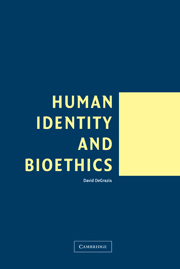Book contents
- Frontmatter
- Contents
- Acknowledgments
- 1 Introduction
- 2 Human Persons: Numerical Identity and Essence
- 3 Human Persons: Narrative Identity and Self-Creation
- 4 Identity, What We Are, and the Definition of Death
- 5 Advance Directives, Dementia, and the Someone Else Problem
- 6 Enhancement Technologies and Self-Creation
- 7 Prenatal Identity: Genetic Interventions, Reproductive Choices
- Index
4 - Identity, What We Are, and the Definition of Death
Published online by Cambridge University Press: 05 June 2012
- Frontmatter
- Contents
- Acknowledgments
- 1 Introduction
- 2 Human Persons: Numerical Identity and Essence
- 3 Human Persons: Narrative Identity and Self-Creation
- 4 Identity, What We Are, and the Definition of Death
- 5 Advance Directives, Dementia, and the Someone Else Problem
- 6 Enhancement Technologies and Self-Creation
- 7 Prenatal Identity: Genetic Interventions, Reproductive Choices
- Index
Summary
How should we understand human death? What role should personal identity theory play in determining an answer? After providing a historical, conceptual, and scientific introduction to the debate over the definition of death, this chapter addresses these and related questions.
INTRODUCTION TO THE DEBATE
Before the middle of the twentieth century, there was little controversy over the criteria for human death. Occasional cases of premature burial in the nineteenth century generated alarm, but concerns about the accuracy of diagnosing death largely abated by the turn of the century. In the 1960s widespread dissemination of such new technologies as respirators, defibrillators, drugs that stimulate various bodily functions, and intensive care units created the possibility of radically separating cardiopulmonary failure and cessation of neurological function. Thus, respiration and circulation could be artificially maintained for months or even years after consciousness was irretrievably lost. These developments motivated the question of what constituted human death.
Various practical factors provided additional incentive to address this question. Resource constraints in hospitals raised concerns about expensive yet futile treatment. When was it legitimate to turn off life supports? Certainly, they could be discontinued for patients who were already dead. Meanwhile, interest in transplantable organs created the incentive not to delay unnecessarily in determining that an individual had died. Organs, transplant surgeons realized, were more viable the fresher they were, but could not be removed from living patients; otherwise, the surgery itself would kill the donors, violating the law against homicide.
- Type
- Chapter
- Information
- Human Identity and Bioethics , pp. 115 - 158Publisher: Cambridge University PressPrint publication year: 2005



